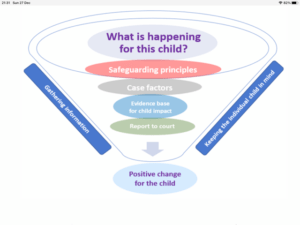Contact Us
If you’re being assessed by CAFCASS, we’d love to hear what it’s like for you. Is it going well or badly? Is it helpful and how has it helped? Are you finding it hard and if so why? What do you make of what you’re going through? Has contact been ordered after a domestic abuse perpetrator programme when it’s not safe ? Has no contact been ordered when it is safe? Have you had false allegations made about you? We want to hear about cases like this and the impact it’s having on you and the children.
Write to us at [email protected].
We are keen to help you through the process and with our years of experience working in the family court (Jill as a solicitor and George as an expert witness) we may be able to give useful advice.
In the new year we will be launching a new podcast which will focus on real life cases based on what people tell us. Of course, as professionals, we will respect the key issues of privacy and confidentiality but we want to help you and others by sharing real life experiences.
Overview of the Child Impact Assessment Framework (CIAF)
IMPORTANT NOTE: Anyone being assessed by CAFCASS should go to their website and find their description of the resources they will use in your case. It’s really important that you know what CAFCASS are going to ask and what they consider important.
The Child Impact Assessment Framework (CIAF) sets out how CAFCASS think children experience parental separation, how the child’s reaction can be understood and what should be done. The framework consists of four guides which Cafcass practitioners can use to assess different types of problem, known as ‘case factors’.
The Case factors
- Domestic abuse where children have been harmed directly or indirectly, for example from the impact of coercive control;
- Conflict which is harmful to the child such as a long-running court case or mutual hostility between parents which can become intolerable for the child;
- Child refusal or resistance to spending time with one of their parents or carers which may be due to a range of justified reasons or could be an indicator of harm caused by a parent alienating a child against the other for no good reason.
- Other forms of harmful parenting due to factors like substance misuse or parent’s mental health difficulties where these are assessed as harmful to the child.
 The CIAF emphasises that safeguarding children and assessing the impact on children are at the heart of the process, which starts when CAFCASS receives the case from the court. The first question they need to ask is, ‘What is happening for this child?’
The CIAF emphasises that safeguarding children and assessing the impact on children are at the heart of the process, which starts when CAFCASS receives the case from the court. The first question they need to ask is, ‘What is happening for this child?’
As the Family Court Adviser (FCA) gathers information, they will use the guidance and assessment processes in the framework to help understand the child’s experience. The FCA is expected to be open to new information as it emerges. The process ends as it started, with the FCA considering what all of the information gathered means for the child - the ‘child impact analysis’ - and leads to recommendations to the court and parents about what arrangements and interventions are in the child’s best interests.
Choosing case factors in a case
As they gather information an FCA can select one or more of the 4 types of case factors listed above and use ‘tools’ and guidance laid out in their website to help them understand the child’s experience. You can see exactly what these tools and guidance are on their website. In addition you will find links to resources for direct work with children, one of which is called, for example, ‘How it looks to me’.
In future blogs I will consider some of these tools or guidance in detail, so subscribe to our blog to make sure you’re alerted to new posts.
The approach expected of FCAs by CAFCASS
So as to give you a good feel for how CAFCASS officers are supposed to use the CIAF, here are the paragraphs of their actual introduction:
- The approach taken in the CIAF builds on that taken in our current Evidence Informed Practice Tools Matrix and in the Domestic Abuse Pathway.
- As this approach has been successful we are now extending it to cover other forms of harm to children in private law proceedings. This will help us keep in mind all potential aspects of a child’s experience.
- The CIAF updates our current guidance and introduces some new material but is not a change of direction.
- As with the Domestic Abuse Pathway, it is expected you will use the framework proportionately at all stages of private law assessments and in all relevant cases, but it’s not specified which tool should be used as this will differ case by case and is a matter for professional discretion.
- The framework establishes from the outset that our key focus is on the impact on the child, the child’s voice and safeguarding and this again is familiar to us. There is no change to these foundations of our practice in Cafcass.
- The framework brings together into one place all the tools and guidance for use in private law cases. The organisation and presentation has been brought up to date and is now more interactive, and on a web page.
- The material is organised into four colour coded ‘folders’ [the 4 case factors listed above]. Each folder can be clicked to take you to the key guidance, tools and resources. Each case factor is colour coded (purple, orange, green and blue). When the FCA clicks into a case factor the framework will take them to all relevant tools and guidance for that factor, the other three remaining case factors will be greyed out whilst they explore that section.
- You will notice that the pink box for ‘direct work with children’ appears under every case factor. If the FCA clicks on this box it will take them to all of the relevant tools and guidance for direct work with children, such as ‘How It Looks To Me’.
- Due to the complex circumstances that many children experience, it is likely that the FCA will need to use tools and guidance from various case factors. The case factors are not designed to be linear pathways and FCAs should navigate fluidly between the different sections depending on the risks present within the case.
- The only exception to this (moving fluidly between factors), is where there are features of domestic abuse and/or harmful conflict. Domestic abuse and harmful conflict are two distinct behaviours and should not be conflated or referenced interchangeably. Where cases feature allegations or indicators of both domestic abuse and harmful conflict, FCAs must prioritise the assessment of domestic abuse and ensure that the risk is adequately reduced/resolved before addressing harmful conflict. A screening tool has been devised to help practitioners distinguish between the two.
- The Domestic Abuse Pathway has been retained in the format of a ‘pathway’ as we are familiar with this, the pathway has been updated as part of this work to bring it up to date.
- The new guidance and tools on harmful conflict and child resistance/refusal, have not been set out as pathways to avoid them being overly ‘linear’ and repetitive.
- These folders contain a small number of new tools and make use of existing tools from the Evidence Informed Practice Tools matrix.
- The case plan document on ECMS will contain a hyperlink to the CIAF. This supports you to apply the guidance and tools as you consider your case plan and as you update it.


